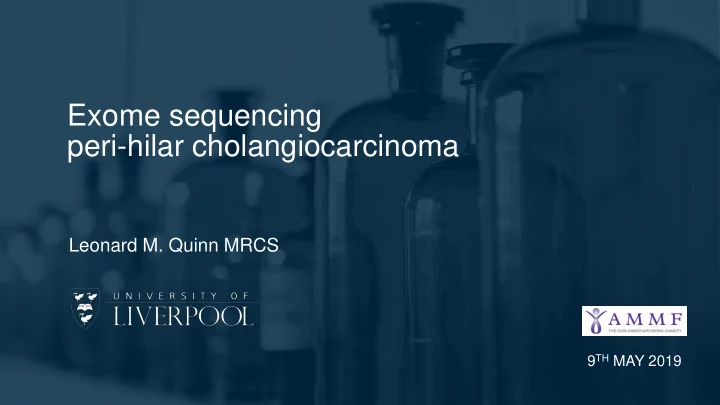

Exome sequencing peri-hilar cholangiocarcinoma Leonard M. Quinn MRCS 9 TH MAY 2019
Agenda 1 Introduction and background 2 Study aims 3 Methodology 4 Results 5 Ongoing validation
Next Generation Sequencing D N A S E Q U E N C I N G 85% disease associated variations. Whole Exome Single nucleotide variants. Sequencing Somatic mutations (non-germline). Exons – Protein coding Non-synonymous, frameshifts.
Sequencing Disparity INTRA-HEPATIC EXTRA-HEPATIC N ≥1750 N = 251 Intra-hepatic only pCCA and distal disease International Eastern predominance Multi-omics platforms Targeted studies in Western cohorts Targeted clinical trials Unmet need
Peri-hilar Cholangiocarcinoma E X O M E R E M A I N S I L L D E F I N E D Nakamura et al, Nature Genetics, 2015. Limited fluke Jusakul et al, Cancer Discovery, 2017. negative Wardell CP et al, J Hepatology, 2018. pCCA Western cohorts targeted panels only.
Relevance to Western populations…. Absence of peri-hilar cholangiocarcinoma tailored chemotherapy?
Aims 1 Characterize mutational landscape of UK pCCA 2 Validate Eastern mutations 3 Identify novel pCCA mutations 4 Elicit actionable targets 5 Functional analyses
TISSUE PREPARATION 40 x pCCA FFPE Tumor and duct Fragment 25 X TUMOR Consultant review Analysis FOR SEQUENCING Microdissection Qiagen DNEasy
Liverpool Centre for Genomic Research FRAGMENT ANALYZER DNA LIBRARY PREPARATION TUMOR X 25 AGILENT SURESELECT V6 260:280 AND 260:230 EXON CAPTURE MAGNETIC BEAD PROBES AMPLIFICATION SANGER VALIDATION ILLUMINA HISEQ 4000 SIGNIFICANT DIFFERENTIALLY 2 X 150 BP EXPRESSED MUTATIONS PAIRED END SEQUENCING >100X COVERAGE BASE CALL ACCURACY AVERAGE NUMBER OF TIMES TRIM Q<20 (1/100) BASE IS READ REDUCE FALSE POSITIVES
Bioinformatics Pathway BWA hg38 (80% mapping). Mapping Reads <10% mapping quality removed. Picard duplicate filtering. Duplicate Local realignment around small insertions and Removal deletions (GATK). Somatic SNV detection (STRELKA). Annotation Significant difference between tumor/normal classified somatic (Fisher’s exact – 5% cutoff).
Spectrum of Inter-tumoral Heterogeneity I. Tumor Mutational Burden (median) = 18/Mb II. Total mutations (median) = 1307 (IQR 1206 – 1653) III. Moderate impact (median) = 334 (IQR 213 – 454) IV. High impact (median) = 53 (IQR 46 – 97)
Comparative Extra-hepatic Landscape Published Liverpool 50% TP53 47% 40% KRAS 10% 15% SMAD4 38% 10% ERBB2 15% 5% BRAF 22%
Validation ongoing I N S T I T U T E O F T R A N S L AT I O N A L M E D I C I N E 4 x known actionable cancer mutations Higher Frequency Established Low frequency (published datasets) Peri-hilar CCA Mutations High frequency Liverpool (coding) Sanger sequencing (n=70) and IHC (n=98)
Validation ongoing I N S T I T U T E O F T R A N S L AT I O N A L M E D I C I N E 6 x novel pCCA mutations High Frequency Coding/promoter Novel mutations Cell cycle arrest/regulation Immune response regulation
Summary U N M E T N E E D I N P E R I - H I L A R D I S E A S E Significant inter-tumoral Differing biological heterogeneity landscape Intra-tumoral heterogeneity? Need for new target based trials Mutations – Higher Western mutational burden Old and new Progressive technology Pathway analysis
Thank you AMMF Mr Hassan Malik Professor Christopher Goldring Professor Daniel Palmer
Recommend
More recommend